|
Co-sponsors of the 2023 Winning Out
Certificates


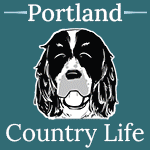
| |
It’s been a
great journey!
 June Richardson was there in the early days when Agility was a strange cross
between fast-paced heelwork - it was all done on the left - working trials and
show jumping. All breeds, sizes and abilities were mixed together in one class. If your dog
could jump 30inches (760mm), then you could take part, and some of the smallest
dogs did remarkably well. There was no Internet, no PCs, mobile phones or Sat Navs.
The stopwatch was cutting edge technology. Now look at it! June
Richardson, founder of Agility Aid, looks back at how agility came into 21st
Century. June Richardson was there in the early days when Agility was a strange cross
between fast-paced heelwork - it was all done on the left - working trials and
show jumping. All breeds, sizes and abilities were mixed together in one class. If your dog
could jump 30inches (760mm), then you could take part, and some of the smallest
dogs did remarkably well. There was no Internet, no PCs, mobile phones or Sat Navs.
The stopwatch was cutting edge technology. Now look at it! June
Richardson, founder of Agility Aid, looks back at how agility came into 21st
Century.
In the
beginning in order to find a show, we had to scour Dog Training Weekly
which was a magazine more orientated to Obedience but it was the closest thing
we had. Once we found a show, we had to send a stamped, self-addressed envelope
off to the Show Secretary and then wait for a schedule to be posted back to us.
We then had to complete a lengthy entry form, post it back again with a cheque
or postal order to cover the fees and then wait again with great excitement for
the post to arrive. We had to assume our entry had been received.
A truly ‘random’ draw
Upon receipt of an entry, the show organisers would record the names
of dog and handler and assign the next ring number to them. I don't know if all
clubs were the same, but my club (Tunbridge Wells) would put a cloakroom ticket
with that number into a 'hat' – one 'hat' for each class entered. Cheques and
postal orders – and sometimes cash – would be banked. Once the entries had
closed, the tickets in each 'hat' would be shuffled and then withdrawn, one by
one. This created the running order for that class. The list of ring numbers in
running order would be written out by hand to be pinned up at the show, and
later to be used as a calling list.
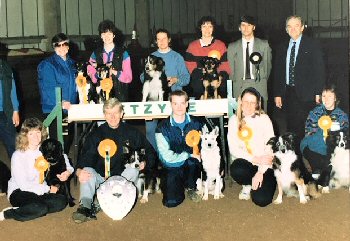 On the
day of the show, eager people and dogs would arrive at the field or riding
school in all sorts of transport, ranging from open-topped sports cars to taxis
and family saloons. The equipment in the rings was mostly home-made equipment and
usually there was a liberal spattering of manure. We had to queue at the
Secretary's tent to collect a card with our handwritten number on it and would
then queue again to find our ring number on the pinned lists of running orders
so we could make a note of them on the back of the ring card. On the
day of the show, eager people and dogs would arrive at the field or riding
school in all sorts of transport, ranging from open-topped sports cars to taxis
and family saloons. The equipment in the rings was mostly home-made equipment and
usually there was a liberal spattering of manure. We had to queue at the
Secretary's tent to collect a card with our handwritten number on it and would
then queue again to find our ring number on the pinned lists of running orders
so we could make a note of them on the back of the ring card.
We would
all sit in chairs round the ring to watch and wait for our turn. If it was
raining, we could still watch the ring from our car, parked round the perimeter
of the ring. The aim would be to go clear so that you could then run again
against the clock to find a winner. We were timed with a stopwatch, and our
details and faults were recorded on a scribe sheet. Timers became the best-known people in
Agility. Jimmy ‘in your own time, young lady’ White was loved by everyone.
Scores were written on a huge sheet of paper by ring number only, so the
identity of the winner was usually not known until the prize-giving.
As the
sport grew, it became necessary for the competitors to be categorised by ability
in order to keep class sizes under control, with only Starters (Grade 1 and 2)
retaining the joy of running off clear rounds, although that soon had to be
abandoned, too. Equipment and courses got more professional and challenging, and
handling got more technical as class size continued to grow, but the paperwork
and system remained largely the same.
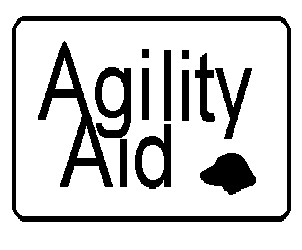 The start of ring paperwork The start of ring paperwork
It was in 1985, whilst jostling for position in a huge crowd of
competitors around a minutely written calling list for a Spillers Knockout
competition, that I thought 'there's got to be a better way,' and the seeds of
Agility Aid were sown.
At the
time, PCs were available, but they were very expensive. That year, however, Alan
Sugar produced the Amstrad Word Processor as an MS-DOS-based machine and
suddenly it was affordable. It became so instantly popular that software
companies provided packages and languages for it, including dBase which I was
very familiar with.
So I
went out to purchase an Amstrad. I loaded dBase and by early 1986, I had
completed the design and programming. My club bravely allowed me to trial it at
their show. They retained the manual process, too, home computers still being
considered a bit new-fangled! At this stage, I was just processing the running
orders for the show, but with handlers and dogs details entered and running
orders created, I was easily able to print off any number of the lists required,
thus easing congestion round the boards at the show and producing the start of
the ring paperwork.
I
thought the system would only be used at my Club's shows, but Downlands
approached me afterwards and asked if I would do it for their show, too. Agility
Aid was born, the first ever computer processing service. The journey from paper
to pixels had begun.
Holding
the dog/handler/running order information on computer opened up all sorts of
possibilities and the existing show paperwork soon started to look very
different. Mostly the difference was in the amount of information that could be
provided. Score sheets had the biggest change, going from a huge sheet of just
ring numbers by column, depending on the faults, to A4 sheets by running order.
Suddenly you no longer needed to know your score to find out your score, you
just needed your running order. It seems obvious now, but it took a bit of
explaining to people! Scribe sheets retained their design but got pre-populated,
and together with Score Sheets could be tailor-made to suit the competition. In
those days we would have gamblers, knock-outs, snooker, take-your-own-line, etc,
and there was paperwork designed to match.
|
Agility
Aid's popularity grew as the sport grew and more and more clubs were using our
services. I went full-time, and then husband Paul joined me. Worcester Club
asked if I had considered taking entries as well as processing them and Agility
Aid moved on into another phase. In those days all entries were made by post and
the postman loved us. We were his only stop, as our bag would fill his weight
quota. Kate Austin and then Lisa Greenhow joined us to help receive entries.
One
memorable weekend we received, processed and posted every agility run in the
country! Class sizes were getting enormous and I had to re-program the paperwork
many times, to allow for four digits in the running order, split classes, new
grades, new sizes etc. At the Hemel Hempstead show one year, the running orders
for the Olympia Pedigree Chum qualifier went over 1000 and the competition
continued from the Saturday into the Sunday, all with the same judge who, I
think,
was John Gilbert. At that time, qualifier classes were not allowed to be split.
When are you running? 'Tomorrow' was the silliest answer to give.
|
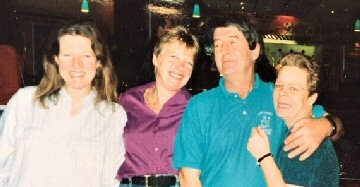
The DiN results team
June Richardson, Alyson Martin, Paul Richardson and Eve Leach |
We also
tried to do at-show results, starting with Tunbridge Wells show. Laptops were
not available yet – at least within budget - so this entailed taking a PC and
printer, with batteries and an inverter. We continued to do it for Tunbridge
Wells for a while, but it wasn't really practical and we didn't have the time to
attend other shows, so could only offer post-show results. All except Dogs in
Need, where for over 20 years we moved our entire office to the Showground,
where electric hook-up made the results service possible. I would dearly have
loved to set up a central results area with a constantly updating monitor, but
wireless wasn't available then.
As more
and more information was provided to competitors, more and more was required.
The backs of ring cards became crowded with information, to help competitors
know where in the huge shows their runs would be. Ring cards were posted out,
with ring plans, show information, helpers lists, etc. The Agility Aid offices
resembled a major post room, and for big shows 'stuffing' could take two days.
Show paperwork could take up to four huge archive boxes. I felt as though I
killed a small forest for every show! Fortunately there were other processors
now on the scene, but still the workload was enormous.
In 2001
Foot 'n Mouth struck in Britain. Suddenly there were no shows to process,
although lots to cancel and rebates to make. But an ill wind, as they say….
Internet access was starting to improve, and things really started to happen.
There was still no broadband, but we had moved on from dial-up and modems.
Technology was starting to speed up, mobile phones were becoming affordable, SMS
was able to be used across providers. Competitors needed to know what was
happening with shows, and show secretaries needed to let competitors know –
sometimes at very short notice. Agility Aid set up an email notification system
providing information to competitors on what was happening with the shows they
had entered.
Agilitynet, which was launched in 1998, really came into its own then. It went
on to be the go-to site for all Agility information, and now covers a huge
variety of topics in more than 1000 articles and information for and about
Agility. It is still arguably the only website to cover the whole Agility
spectrum of information.
Taryntimers brought in electronic timing, the first real sign of technology
reaching the show venues, albeit with taped down wires everywhere, but it was a
major leap in the sport. The digital journey was reaching a corner, I finally
had some time to think and another idea was beginning to form.
 The first ever online entries The first ever online entries
I
approached Kate Austin and her partner Dave Jolly with my idea to see if they
wanted to join my husband Paul and me, and iSS was born. Instead of people
posting their entries, which we transcribed onto computer to be processed, why
not let them enter online, where it could be checked and mistakes rectified
before processing. Unbeknown to me Fosse Data were creating something similar
for Breed shows, and we launched almost simultaneously.
Dave
managed to convert my rather mad idea into a fully functioning website and our
new venture was launched at 2002 Dogs in Need. We held a large meeting at Dogs
in Need to explain how it worked, but people were still very wary. At that
stage, the newly formed company wasn't able to offer credit card payments, so I
came up with the idea of the iSS Bank, allowing competitors to pay into their
own account. Basically we were asking people to trust
us with their money!
Very
bravely Gillingham (Dorset) DTS agreed to be our first customer. As with most
new things, initially it was greeted with great scepticism, but soon the
benefits to competitors and show secretaries alike became obvious and iSS really
took off.
Although
iSS was launched from the strength of Agility Aid I wanted to keep them as two
separate companies. iSS received the information and Agility Aid did the
processing. As two separate companies it meant iSS could receive entries for
anyone – they didn’t have to be Agility Aid customers – and Agility Aid could
process entries for anyone – they didn’t have to have online entries. Subsequent
processors perform both tasks, and Agility Aid now does both as well, but it was
a split that worked well and benefitted everyone.
Between
the four of us, we were able to produce more of the paperwork more quickly
digitally for many shows. Ring cards could be downloaded, together with the show
information paperwork – ring plans, helpers lists, etc. An online processing
system was added for Show Secretaries who were happy to do that work themselves.
 As
technology improved, mobile phones got better and cheaper so handlers could
subscribe to SMS messages providing information on shows going live and closing.
The iSS Hotline, a phone service for important show announcements such as last
minute cancellations, etc. was introduced. It received KC approval as the means
for Show Secretaries to inform competitors of urgent problems, and the number
was added to most schedules as the one central contact for that information.
Before then Show Secretaries had to contact competitors individually, often from
the middle of a field. As
technology improved, mobile phones got better and cheaper so handlers could
subscribe to SMS messages providing information on shows going live and closing.
The iSS Hotline, a phone service for important show announcements such as last
minute cancellations, etc. was introduced. It received KC approval as the means
for Show Secretaries to inform competitors of urgent problems, and the number
was added to most schedules as the one central contact for that information.
Before then Show Secretaries had to contact competitors individually, often from
the middle of a field.
My
original vision for iSS was to offer more than just receiving and validating
entries – hence the name of internet Show Services – but the service became so
popular and technology improved so quickly there was little time for anything
other than continued development of the digital possibilities. I still had
visions of continuing the digital path to the shows themselves, finally keeping
the whole process digital, but there was still no decent connectivity in the
middle of fields. Electronic timing already meant the area was criss-crossed
with wires and adding to them was not an option. A few systems were tried by
others but they all came down to the wire – literally!
Fortunately, others started to take up the mantle, and there is now a healthy
number of companies combining the two roles – receiving and processing.
Connectivity has improved as well, and with fresh faces and ideas on the scene,
the digital world has finally reached the show venues themselves with real time
results and full web access. Seeing that early dream finally coming true, albeit
more than 30 years later, gives me great joy.
In 2016,
Agility Aid was transferred to James Greenhow who was already running Red Dog
Processing. It was a timely move as it was just as the show venues were turning
digital. James has been able to take Agility Aid to the next level, and now it
is providing the full digital service – receiving online entries and providing
at-show scoring and results – as well as processing. I'll leave it to James to
complete that story. In 2017 Kate and Dave left iSS, transferring the on-line
entry business to their new company Agility Shows Online (ASO).
The iSS Show Hub
With the
increase in the number of shows and online processors, competitors seemed to be
struggling to keep up with who was doing which show. I realised there was still
something missing. We were so busy travelling the digital road we forgot to
check behind!
Back in
the early days of agility, there were not so many shows. They were all Kennel
Club (KC) and took place mostly in the summer. In 1998, we (Agility Aid)
published the first Agility Diary, designed to provide details of UK
agility shows in one place. In October, I would contact the Show Secretaries for
information about their show for the following year. The Diary was printed in
November and would be sold out by January. But as the number of shows have
multiplied throughout the year, the Diary soon becomes out of date. A printed
format cannot compete with the flexibility of the new technology.
After
splitting with Kate and Dave, I found myself with the time and the opportunity
to fulfil my dream of a free internet service for agility show organisers and
competitors.
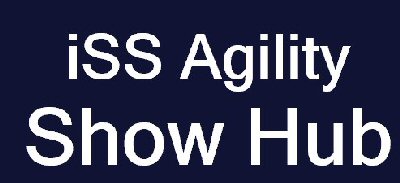 I came
up with the idea of the iSS Agility Show Hub, a single website dedicated to
providing information about agility Shows, regardless of type (KC, UKA,
Independent, etc) or processor. Show Organisers can log in to their own free
account and post their show details, advertise their shows with descriptions and
images, post their schedules and show news. This creates the Show Diary, which
displays in the same format as the printed one, but digital and, therefore,
always current. Closing dates, newly available schedules and urgent show news
all appear on the front page of the site, so instantly accessible to everyone.
This information is also copied to the Agilitynet website so show secretaries
only need to post once for it to be out there. Rather than emailing bulky
schedules as attachments, they can be uploaded and a link is passed on to
Agiltynet. I came
up with the idea of the iSS Agility Show Hub, a single website dedicated to
providing information about agility Shows, regardless of type (KC, UKA,
Independent, etc) or processor. Show Organisers can log in to their own free
account and post their show details, advertise their shows with descriptions and
images, post their schedules and show news. This creates the Show Diary, which
displays in the same format as the printed one, but digital and, therefore,
always current. Closing dates, newly available schedules and urgent show news
all appear on the front page of the site, so instantly accessible to everyone.
This information is also copied to the Agilitynet website so show secretaries
only need to post once for it to be out there. Rather than emailing bulky
schedules as attachments, they can be uploaded and a link is passed on to
Agiltynet.
For
competitors, it provides a single website where, regardless of the show, show
type or processor, they will have instant access to show dates, availability of
schedules, and urgent show news. All this is free to everyone and provides a
central Show Information Hub which is always current and available on PC, tablet
and mobile.
Competitors can register with iSS for free, to join the iSS community, and this
will provide them with an area for keeping information on their dogs, keeping
track of their wins, etc. They can also keep photos on there and nominate one to
be available for the ever-changing Front Page. And when the worst happens they
can let people know on our Rainbow Bridge, which is for all our dogs, not just
the super stars.
The Hub
also provides an Interactive Diary which is available on subscription but is
free for seven days to new registrations or returning iSS registrants from the
online processing days. Competitors can view full information on shows, download
schedules, click through to the processor and use it on a mobile as a Sat Nav to
the venue. People can personalise their own Diary by colour coding shows of
particular interest and they can add their own dates – birthdays, MOT, booster
jabs, anything, and have the option to view the full Show Diary, a filtered Show
Diary, or just My Diary. The full Show Diary, the filtered Show Diary and My
Diary can also be printed, providing a hard copy.
So that
completes the digital path. The iSS Hub begins the Agility show journey, where
show organisers can use their account to work on, store and post their Show
information, creating the free Show Diary and Front Page notice board. From
there the Interactive Show Diary provides the link straight through to the
processor for entering, processing, scoring and results. A complete path - and
hardly a bit of paper in sight.
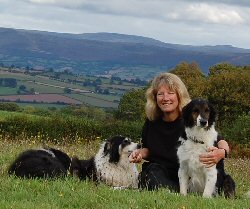 About the author... About the author...
June
Richardson started in agility in 1984 with her Labrador Klute (Midnight Klute).
Not having followed the normal route to agility – via obedience – she naturally
started handling on the right and was able to beat the collies. Together they
reached Advanced (Grade 7), Olympia (before ABCs), Crufts and many other major
finals. She became much sought after as a trainer, particularly for right hand
handling.
As well
as creating Agility Aid and iSS - and most of the paperwork used - June was
responsible for some other things we take for granted: dedicated gardens when
camping (orange fencing), Veteran classes (Golden
Oldies) and Any Size classes (Agility Aid Allsorts). The
popularity of Klute at Olympia, with a few hints and suggestions from June,
caused the sponsors Pedigree to seriously start thinking about ABC
qualifiers.
Having
survived breast cancer in 1998, June stopped competing in 2008 when struck with
Transverse Myelitis. If paragility was more available then she would probably
still be competing now, but she feeds her agility obsession by immersing in the iSS
Hub.
First published 19th December 2019
| |
|